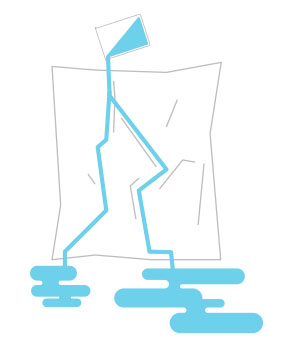During a rainstorm, the water that flows over the land as runoff collects in channels such as streams, canals, rivers, etc. The land area that drains water is called a watershed.
What is a Watershed?

Areas of higher elevation called divides separate watersheds from each other. Water flows through a series of channels and eventually it collects in a wide river that empties into a body of water such as an ocean or lake.
From an aerial view, drainage patterns in a watershed resemble a network similar to the branching pattern of a tree. Tributaries, similar to twigs and small branches, flow into streams, the main branches of the tree. Streams eventually empty into a large river, comparable to the trunk. Like other branching patterns (e.g. road maps, veins in a leaf, the human nervous system), the drainage pattern consists of smaller channels merging into larger ones.
Objectives
- Understanding influences on the watershed.
- Predict where water flows within a watershed.
- Observe drainage patterns in a watershed
Materials Needed
- Sheet of white paper
- Shallow pan
- Water-based color markers
- Spray bottle of water
Instructions
- Crumple sheet of paper and then partially smooth it out being careful to leave some ridges.
- Using markers, color along the crease using different colors. The colors will represent pollutants such as fertilizers, pesticides, litter, pet waste, etc.
- Lay sheet of paper in pan and shape it so it looks like a watershed.
- Spray paper with water and watch colors begin to flow.
Topics for Discussion
- Describe what happened at the highest and lowest point in the watershed.
- Did the different pollutants mix together?



